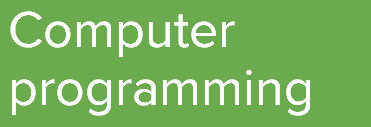Many teachers have heard of Khan Academy related to Math instruction, but did you know that Khan has a course completely dedicated to learning coding? The Computer Programming course is broken down into 13 units with an average of 5 lessons per section. The units are:
- Intro to programming
- Drawing basics
- Coloring
- Variable
- Animation basics
- Text
- Functions
- Logic and if Statements
- Looping
- Arrays
- Objects
- Object-Oriented Design
- Become a better programmer
I have been slowing working my way through the curriculum and can recommend this course starting from 3rd grade on up. Obviously, the younger grades will need more support, but Khan uses their proven pedagogical practice of teaching (through video) and then having you immediately start practicing.
By immediately being able to view the code they are writing, student receive instant feedback of both their successes and errors. Khan even highlights coding errors so students can see their mistakes immediately. Naturally, each unit becomes more complex and it is important for the teacher to remember that then end goal of this course may not be completion, but rather exposure to the process of coding. When I poll my students of what they want to be when they grow up, I often hear “I want to make video games”. The problem with this and many professions students throw out is they have little understanding of what skills the job requires. By the end of unit two, my students have a basic framework of the skills required to make a game and they realize it is something they will really have to work towards to become proficient.
 At the homepage of the Computer Programming section, Khan has a link to “Browse Programs”. This is nothing short of magical for students to view. This section allows students to view other programmers work and interact with their programs. What sets this apart from everything else out there is Khan leaves the actual coded program on the left hand side of the screen. In addition, students are allowed to change the code anyway they would like and “Save as a spin-off”. This offers an endless amount of tweaking with actual running programs. Below is an example of a version of the game Cut the Rope made in Khan Academy and freely available for students to manipulate.
At the homepage of the Computer Programming section, Khan has a link to “Browse Programs”. This is nothing short of magical for students to view. This section allows students to view other programmers work and interact with their programs. What sets this apart from everything else out there is Khan leaves the actual coded program on the left hand side of the screen. In addition, students are allowed to change the code anyway they would like and “Save as a spin-off”. This offers an endless amount of tweaking with actual running programs. Below is an example of a version of the game Cut the Rope made in Khan Academy and freely available for students to manipulate.
If you are a Google Apps for Education school, using Khan is very easy. Khan will let students log in with their Google Apps for Ed account and they are off and running. If you don’t have Google accounts for your student (You should really look into getting them), Khan has its own log in system that doesn’t require student emails. You can also use the Facebook log in system if many of your students have an account.
After students are logged in the first thing you should have them do is add you as their coach. The first screen students come to after logging in the dashboard. On the left hand side of the screen are options for the student. The last option is coaches.
 Once the student clicks on coaches link, there is a field to add the email address of their coach. Have the students add the email address of your account and you are set. You have full access to reports, grouping, and class data. These stats apply to all units of study in Khan.
Once the student clicks on coaches link, there is a field to add the email address of their coach. Have the students add the email address of your account and you are set. You have full access to reports, grouping, and class data. These stats apply to all units of study in Khan.
Even if you have only one computer in your classroom, the Computer Programming section works great as a station. In addition, students can access all of this content from home 24/7. Adding this option to your class is a great way to extend the momentum around the hour of code and engage a new generation of programmers.
As always, share your comments or stories of how you have used Khan Academy in your classroom in the section below.




